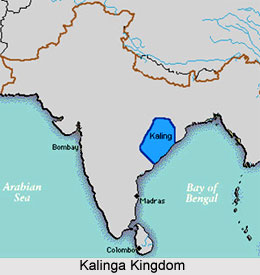 Kalinga, is an ancient legendary Indian kingdom. In the epic Mahabharata, it is mentioned that Kalingas assisted Duryodhana in the Kurukshetra War as Duryodhana`s wife belonged to Kalinga.
Kalinga, is an ancient legendary Indian kingdom. In the epic Mahabharata, it is mentioned that Kalingas assisted Duryodhana in the Kurukshetra War as Duryodhana`s wife belonged to Kalinga.
Kalinga`s name is associated with the five royal lines of Anga, Vanga, Kalinga, Pundra and Suhma. They were the five adopted sons of king Bali, the Asura were born from the adopted sons of king Bali. Actually they were the son of the great blind sage Dirghatamas. Dirghatamas was discarded by his wife and sons and thrown in the river Ganga. King Bali saved Dirghatamas. King Bali came to known about Dirghatamas and decided to raise the sons of the sage and hence adopted them. Later the five royals became the famous five kings. After them the five countries were named.
In evidence it is mentioned that the Kalinga were invited in the swayamvara of Draupadi.
After Sahadeva`s, one of the Pandavas conquest he received tributes from the Kalingas and the Ushtrakarnikas and other states. Dantapura was mentioned as the capital of Kalinga conquered by Sahadeva.
The inhabitants of the Kalingas along with the Angas, the Bangas, the Avasiras and others had to pay dues when Karna conquered this place.
Vasudeva Krishna defeated a Kalinga king. Bhima, the Pandava prince also conquered the Kalingas along with all the people of Kasi and Anga and Magadha. Bhargava Rama vanquished the Kalingas along with the Angas and Vangas.
When Yudhisthira entered into his new palace in Indraprastha the Kalinga king, Srutayus attended the ceremony along with Jayasena, king of Magadha.
Yudhisthira`s Rajasuya sacrifice was also attended by the Anga, Vanga, Kalinga, Pundra and Suhma.
Duryodhana, the eldest of the Kaurava brothers married the daughter of Chitrangad. Chitrangad was a Kalinga king. In a mythical story it is related that once a group of rulers went to conquer Kalinga, the city of opulence. Kalinga was known as Rajapura.
Duryodhana with assistance of Karna proceeded to Kalinga to attend the swayamvara of Chitrangad`s daughter. The other rulers who went there were Sisupala, Jarasandha, Bhishmaka, Vakra, Kapotaroman, Nila, Rukmi, Sringa and the Bhojas, Ashoka and Satadhanwan and many more. That fair lady passed by Duryodhana without selecting him. Duryodhana was infuriated and cannot accept the rejection. Suddenly he snatched her with force and took her away.
Kalinga is a place of pilgrimage too. When Arjuna was on a twelve year journey to the holy places he visited all the regions of sacred waters and other holy places in Vanga and Kalinga.
When the Pandava brothers went to twelve years of exile they too went the land where the Kalinga tribes were inhabited. The Kalinga King Srutayudha or Srutayush was one among the generals in the Kaurava army. Bhima slew Kalinga king Srutayush and other Kalinga heroes.
In the Puranas it is mentioned that Lord Shiva worshipped in the country of the Kalingas in the form of a tiger. Lord Shiva has an image in the country of the Kalingas called the Vyaghreswara.
In Kalinga no Brahmans were found, only the Sakas, the Yavanas, the Kamvojas and other Kshatriya tribes were found.



















